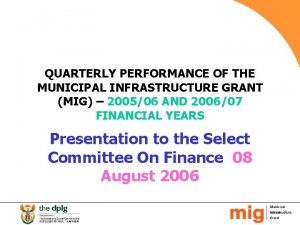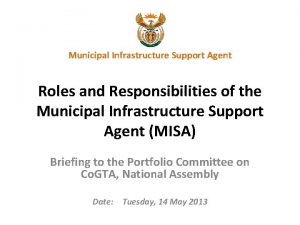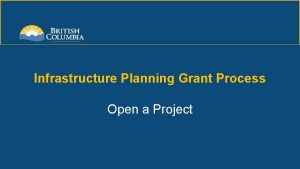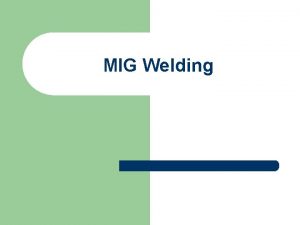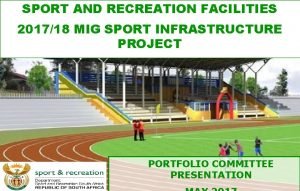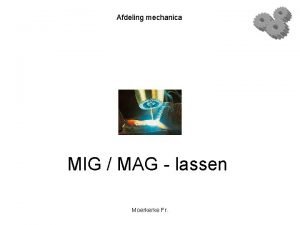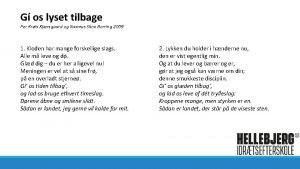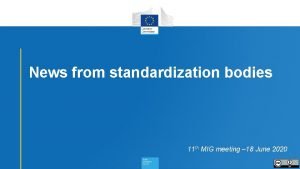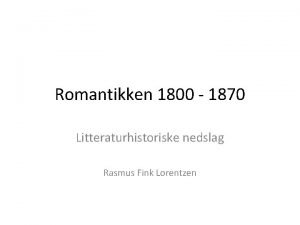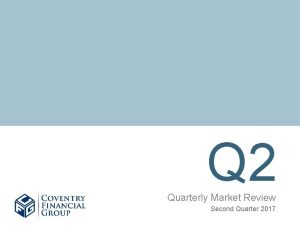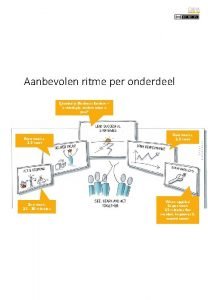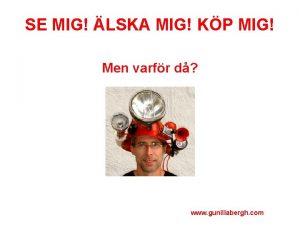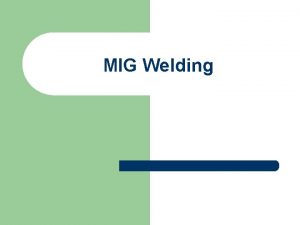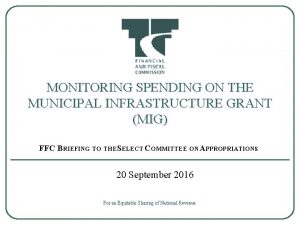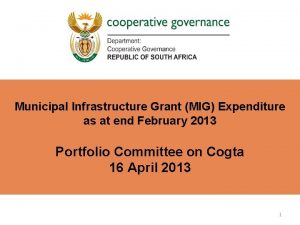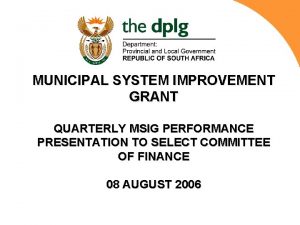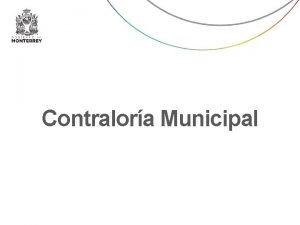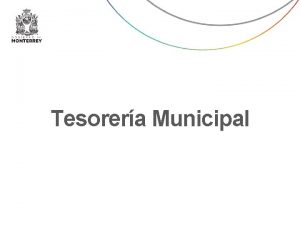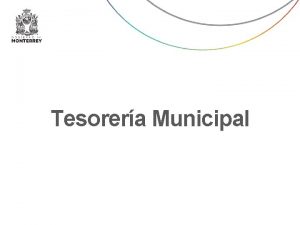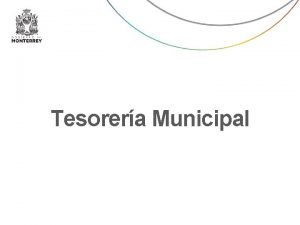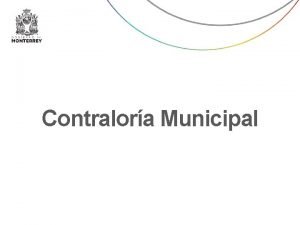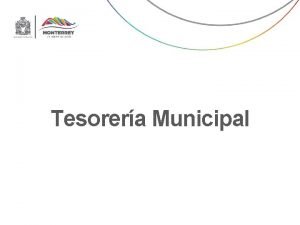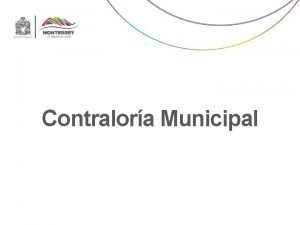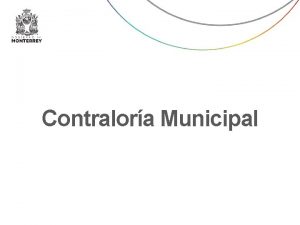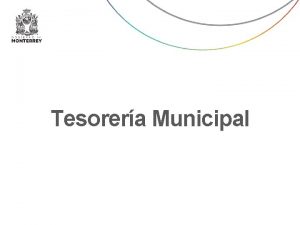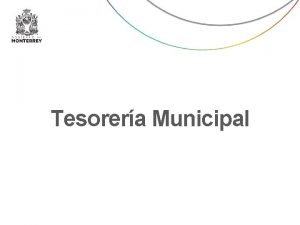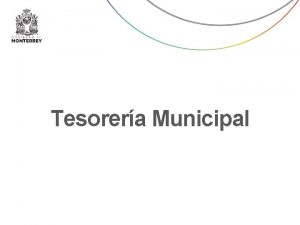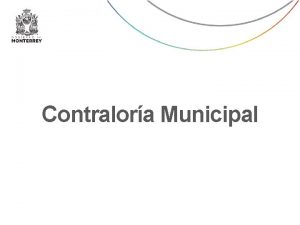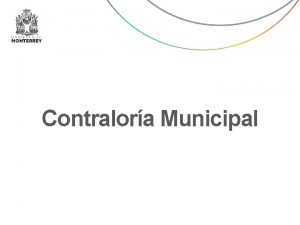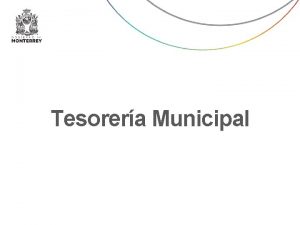QUARTERLY PERFORMANCE OF THE MUNICIPAL INFRASTRUCTURE GRANT MIG


































- Slides: 34

QUARTERLY PERFORMANCE OF THE MUNICIPAL INFRASTRUCTURE GRANT (MIG) – 2005/06 AND 2006/07 FINANCIAL YEARS Presentation to the Select Committee On Finance 08 August 2006

Quarterly financial progress

PART A: 2005/06 REPORT • Municipalities spent R 5, 3 billion out of the total allocation of R 5, 4 billion as at the end of June 2006 • Expenditure represents 97 percent of the total transferred and the allocation • Gauteng (98, 9 percent), Western Cape (99, 8 percent), Eastern Cape (98, 9 percent), and KZN (98 percent) are the best performing provinces • Municipalities had R 184 million MIG funds in their bank accounts – end June 2006 • municipal spending started lower at R 400 million in the first quarter of 2005/06 and improved to R 1, 7 billion in the last quarter of 2005/06 financial year • Municipal expenditure is normally lower in the first quarter of the municipal financial year • This means that in the first quarter most municipalities are still finalising their budgets for approval by their councils before the start of the financial year

PART A: 2005/06 REPORT


PART A: 2005/06 REPORT • Municipalities have been spending less than what was transferred to them for all the quarters except the last quarter where municipalities spent more than what was transferred to them • One other reason for higher expenditure in the last quarter is that most municipalities reported higher expenditure since they felt that they would loose some money if the does not spend the money • The dplg informed municipalities of the processes to be followed in dealing with unspent funds from the 2005/06 financial year • As at end of March 2006, municipalities reported the under expenditure of over R 1, 4 billion

Q 5: Expenditure on under expended funds from 2005/06 financial year

EASTERN CAPE

FREE STATE

GAUTENG

KWAZULU-NATAL

LIMPOPO

MPUMALANGA

NORTHERN CAPE

NORTH WEST

WESTERM CAPE

IMPORTANT FACTS TO NOTE ON MIG EXPENDITURE • Municipal Infrastructure Grant integrated various grants • Grants were managed by different sector departments. • Implementation earmarked to kick start from 2006/07 financial year • Implementation brought forward with two years starting in 2004/05 • Allocations were much more than were anticipated • Resulted with a lot of challenges for municipalities • No proper arrangements were in place to phase-in municipalities in the new arrangement of infrastructure delivery • Project Management Grant for provinces phased out • Situation has led to significant under expenditure in the first and second years of MIG implementation • Situation has since improved during 2005/06 financial year

IMPORTANT FACTS TO NOTE ON MIG EXPENDITURE • Majority of municipalities in Kwazwulu-Natal and Western Cape spent 100 percent of their MIG allocations by end of March • Main contributing factor of slow spending is the different planning cycles between the national financial year and the municipal financial year. • Municipalities start planning after their councils approve their capital budgets around end June each year • Projects designs and procurement processes take some time • most projects start implementation from the beginning of January the following year • Kwazulu Natal and Western Cape municipalities are good examples regarding good planning to be able to spend MIG funds end of March each year • However, provincial capacity depleted

PART B: 2006/07 REPORT

PART B: 2006/07 REPORT • The total MIG allocation for the 2006/07 financial year is R 6, 2 billion • R 875 million transferred to municipalities in the first quarter • municipalities spent R 511 million in the 1 st quarter • Expenditure represents 8 percent of the total allocation and 58 percent of transferred amount • Municipalities focused on spending the remaining 2005/06 MIG funds (spent R 1, 2 billion) • Negative impact on spending the current allocation • Close monitoring is in place to inform the re-allocation process

Q 1 - 05/06 vs Q 1 – 06/07 • During the first quarter of 2006/07 the amount transferred to municipalities was less than that transferred during the first quarter of 2005/06 • some of the municipalities did not schedule any transfers during the first quarter because they had to spend the remaining funds from the 2005/06 allocation • municipalities targeted to expend the 2005/06 funds by the end of June 2006 • expenditure in the first quarter of 2006/07 is higher than the expenditure for the same period last year • The spending of the remaining 2005/06 funds during the first quarter of 2006/07 financial year impacted negatively on the expenditure of the 2006/07 funds.

MIG KPI REPORT MARCH 2006

Monitoring Process 1 st July/30 th June Start 2 nd Quarter end 1 st Quarter ·Annual report published 31 st July Municipalities to submit KPI report 15 August PPMU’s submit to Sector Department 31 st August Sector Department submit verified info to PPMUs 10 th September PPMUs Submit Provincal report to National MI Unit 20 th September National MI Unit submit National report to Executive manager 1 st April/31 st March Start 1 st Quarter end 4 th Quarter · 3 rd Quarter KPI report published 1 st October/30 th September Start 3 st Quarter end 2 nd Quarter · 1 st Quarter KPI report published 1 st January/31 st December Start 4 th Quarter end 3 rd Quarter · 2 nd Quarter KPI report published

Progress as end March 2006 Water supply is the most important basic service funded through MIG to poor communities in South Africa. Water services projects registered make up 44% of the total MIG value of registered residential projects at dplg. The next two biggest funding categories on MIG were sanitation (26%) and roads (23%).

Progress as end March 2006 Million % B (basic residential infrastructure) R 17, 894. 27 90. 29 P (public municipal service infrastructures) R 1, 877. 79 9. 47 E (social institutions and micro-enterprises infrastructures) Total R 47. 24 0, 24 R 19, 819. 30 100, 00 Since the start of MIG, R 19 819. 30 million (The total value of all the MIG projects, including the multi-year projects, registered on the dplg database) has been allocated to the B, P and E funding. The bulk of the funding for registered projects in the programme is contributed from MIG and is 79. 06% of the total source of funds to date. The contribution from the public (e. g. municipality’s own funds) and private sectors are 19. 31% and 1. 63% respectively since the inception of MIG.

Progress as end March 2006 Up to the end of March 2006, 17 584 599 person days employment opportunities have been created through MIG projects. The employment opportunities for women as a percentage was 34% of the total employment opportunities. The employment of youth was also 34% of the total employment opportunities.

Progress as end March 2006 Although many MIG projects are labour intensive not all are necessary EPWP projects. The dplg only recently started to register labour intensive projects that adhere to the EPWP guidelines. Up to the end of March 2006 there were 290 registered MIG projects captured as EPWP projects with a total MIG value of R 1 341. 28 million. At the end of March 2006 the total number of Small Medium and Macro Enterprises is 1 321 and 442 Black Economic Empowerment companies was involved on implemented MIG projects by the municipalities.

Progress as end March 2006 As at March 2006, 2 204 956 households have been serviced on completed MIG projects since the inception of MIG in April 2004. Households serviced on Completed Projects Water Up to March 05 (2004/05) Up to March 06 (2005/06) 2005/06 212, 828 245, 733 458, 561 74, 245 145, 457 219, 702 146, 100 174, 247 320, 347 Multi purposes community halls 19, 818 48, 240 68, 058 Multi purposes sport centre / fields 10, 595 124, 429 135, 024 419 20 439 Sanitation Roads Parks and open spaces

Municipal Infrastructure Grant: Commitments

National Overview

CHALLENGES FACING MUNICIPALITIES

GENERAL CHALLENGES FACING MUNICIPALITIES • Planning in the context of Integrated Development Planning. • Intergovernmental cooperation (Municipalities, provinces, and sector departments involvement in MIG implementation) • Overlapping of financial years (National and Municipal) • Lack of capacity to manage MIG projects (Project Management Units) • Appointing service providers (contractors who cannot deliver) • Late payment of service providers • Council decisions take too long (approval of projects and budgets) • Technical reports and Environmental Impact Assessment

INTERVENTIONS IN PLACE Project Consolidate • Operational teams including sector departments visit municipalities for hands on support • SDF’s placed in municipalities • Engineers graduates and students placed in municipalities

THANK YOU
 Mig municipal infrastructure grant
Mig municipal infrastructure grant Municipal infrastructure support agent
Municipal infrastructure support agent Infrastructure planning grant program
Infrastructure planning grant program Infrastructure planning grant program
Infrastructure planning grant program Infrastructure performance metrics
Infrastructure performance metrics Mig in media means
Mig in media means Gmaw welding
Gmaw welding Gmaw electrode classification
Gmaw electrode classification Disadvantages of mig welding
Disadvantages of mig welding Mig sport
Mig sport Stekend lassen
Stekend lassen Gi os lyset tilbage tekst
Gi os lyset tilbage tekst Gmaw diagram
Gmaw diagram Kom til mig alle i som slider jer trætte
Kom til mig alle i som slider jer trætte Ingen pronomen
Ingen pronomen Acetylene cylinder cutaway
Acetylene cylinder cutaway Mig mag
Mig mag Mig welding objective
Mig welding objective Mig meeting
Mig meeting Spectrofobi
Spectrofobi Mig welding pics
Mig welding pics Parametros para soldar con mig
Parametros para soldar con mig Lær mig o skov at visne glad analyse
Lær mig o skov at visne glad analyse Caddy mig c200
Caddy mig c200 Wire speed and voltage chart
Wire speed and voltage chart Russell quarterly economic and market review
Russell quarterly economic and market review Quarterly business review templates
Quarterly business review templates Quarter business review template
Quarter business review template Fidelity quarterly market update q1 2018
Fidelity quarterly market update q1 2018 Quarterly business review examples
Quarterly business review examples Key performance index format
Key performance index format Quarterly business review
Quarterly business review Experian automotive quarterly briefing
Experian automotive quarterly briefing Accesssecure pak
Accesssecure pak Descriptors grading scale and remarks
Descriptors grading scale and remarks
